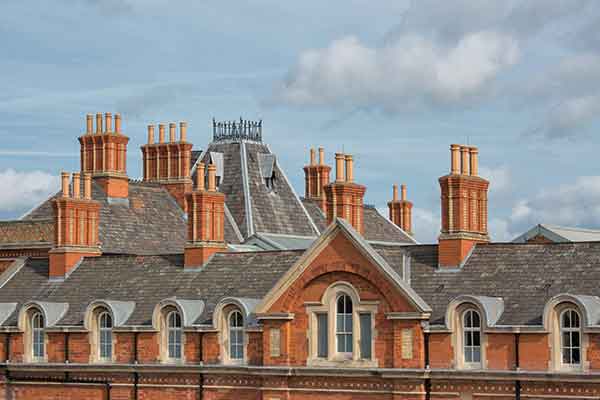Jackie Craven
A chimney pot is an extension on the top of a chimney. The functional purpose of a chimney pot is to create a taller smokestack and a better draft for combustion, because fire needs oxygen to burn and produce heat. A variety of chimney pot designs are available for this function.
A chimney pot is open at one end, to attach to the top of the chimney flue, and vented open at the exposed end. They are almost always tapered but can be any shape — round, square, pentangular, octangular, or sculpted. The Dictionary of Architecture and Construction defines a chimney pot as “A cylindrical pipe of brick, terra-cotta, or metal placed atop a chimney to extend and thereby increase the draft.“
Tudor or Medieval Revival style buildings often have wide, very tall chimneys with round or octagonal “pots” on top of each flue. Multiple chimneys have separate flues, and each flue has its own chimney pot. These chimney extensions became very popular in the 19th century when people burned coal to heat their homes — quickly removing hazardous fumes was a healthy thing to do, and the tall chimney pot put fumes away from the home.
Some chimney pots are beautifully decorated as an architectural expression of an owner’s wealth and social status (e.g., Hampton Court Palace). Other stacks provide historical context of the building and its occupants (e.g., Moorish influences in southern Portugal). Still others have become iconic artwork pieces by master architects (e.g., Casa Mila by the Spanish architect Antoni Gaudi).
Other names for chimney pots include chimney stack, chimney can, and Tudor chimney.
Chimney pots are often called Tudor Chimneys because they were first used to great efficiency during the Tudor Dynasty in Great Britain. Thomas Wolsey began converting the country manor house in 1515, but it was King Henry VIII who really created Hampton Court Palace. Located near London, the Palace is a well-known tourist destination for viewers of ornate chimney pots.
By the 18th and 19th centuries, burning coal for home heating was becoming more common throughout Great Britain. Chimney pots were useful additions to country cottages in England
Chimney pots beyond the British border can exhibit an entirely different design — more integrated both structurally and historically. The fishing villages in the Algarve Region, along Portugal’s far southern shores closest to Africa, often display architectural details that represent the region’s past. Portuguese history is a series of invasion and conquests, and Algarve is no exception.
The design of a chimney pot is a great way to honor the past or express the future. For Algarve, the eighth century Moorish invasion is forever remembered with the design of a chimney pot.
CREDIT / READ FULL ARTICLE AT:
https://www.thoughtco.com/what-is-a-chimney-pot-177265
